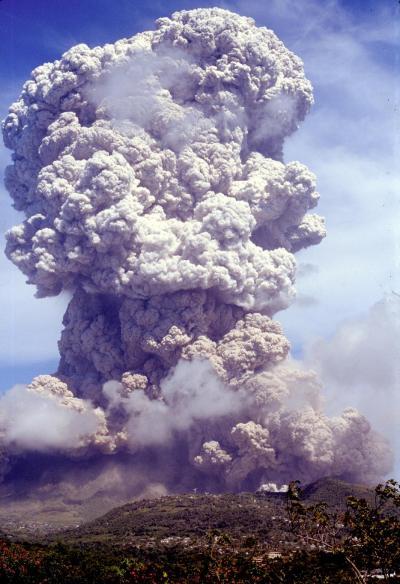"Using land-based measurement, we can see that over the time periods when the magma is erupting, the ground surface deflates into a bowl of subsidence and when the magma is sealed underground, the ground surface inflates like a balloon," says Barry Voight, professor emeritus of geosciences, Penn State. "The interesting thing is that much more magma is erupting than appears represented by the subsiding bowl."
Voight suggests a simple model to explain this discrepancy seen through the various eruptive phases and pauses of the volcano.
In 1995, Soufriere Hills volcano began the current series of eruptions and pauses, with each episode lasting from one to three years. The November 1995 event lasted until March 1998, during which time a thick dome of sticky andesite lava -- a volcanic rock -- grew continuously within the crater, punctuated by occasional and lethal explosions. From March 1998 until November 1999, there was a pause in above-ground volcanic activity and the lava dome collapsed from its own weight and inactivity.

This image shows Soufriere Hills Volcano erupting. Photo Credit: Barry Voight, Penn State
Beginning in December 1999, the second eruptive episode continued until mid-July 2003 followed by a pause until October 2005. The third episode began then and ended in April 2007, followed by a pause, which still continues -- although, according to Voight, "a series of explosions started just a few days ago (early December) and this might mark the onset of the next eruptive period. We will need to wait and see if continuous lava extrusion follows."
The measurements taken during the on-going CALIPSO project, the ground-based phase of this study, uses Global Positioning Systems and strain meters to measure the exact up-and-down and sideways movements of numerous points over the volcano island. However, the volume changes represented by those measurements did not match measured volumes of the actual lava flows during the various eruption episodes, raising an intriguing puzzle.
The SEA CALIPSO project, involving a research consortium directed by Voight and S. Sparks, professor, earth sciences, University of Bristol, UK, used seismic waves caused by underwater air gun explosions at sea to map inside and under the volcano island in the same way as images inside the human body are revealed by a hospital CAT scan.
"In SEA-CALIPSO, we are using a variety of research tools to image the internal structure of the Earth's crust under the volcano island," says Voight. "Our knowledge of the deeper structure under any of the Caribbean Islands is very limited and the internal structure of an active volcano is one of the most puzzling questions in the Earth sciences. It is nearly impossible to get direct measurements inside the volcano, so we rely largely on remote sensing methods."
The researchers used seismic wave arrivals at over 200 land and sea floor seismometers to give CAT-scan like images of structure to about 5 miles deep. They were also able to map how the seismic energy bounces off key reflecting layers near the crust-mantle boundary, around 20 miles down. The basalt at those depths forms horizontal layers that partly crystallize and generate residual melts enriched in silica, water and sulfur. These melts rise in pulses to shallower levels, where they define magma chambers of andesite composition – the lava now erupting on Montserrat.
The researchers are able to image the location of these chambers by their pressure centers, which are approximately 6 miles deep and defined by continuously measured GPS surface stations.
Reporting in three sessions beginning today (Dec. 19), at the American Geophysical Union Conference in San Francisco, CALIPSO researchers discussed many aspects of the project. Voight's model of the Soufriere Hills Volcano accounts for the volume mismatch in erupted magma and ground movement by suggesting an elongated magma chamber beginning below 3 miles and centered about 6 miles beneath the mountain. This chamber fills with magma, but the magma already in the chamber is rich in water, carbon dioxide and sulfur dioxide gases, making it very compressible.
As the chamber fills, part of the new magma pushes against the chamber walls, elevating the island surface, as detected by GPS; but most of the magma fits into the existing space by squeezing the bubbly resident magma. When the volcano erupts, the magma stuffed into the chamber decompresses and the amount of magma erupted is greater than the amount implied by ground subsidence.
"The magma volume in Montserrat eruptions is much larger than anyone would estimate from the surface deformation, because of the elastic storage of magma in what is effectively a huge magma sponge," says Voight. "Magma is continually fed into the chamber from below at a rate of about two cubic meters per second -- about the volume of a large refrigerator every second."
In the long term, the magma released in the eruptive periods is approximately balanced by the accumulated input during the eruptive episode and the preceding inflation. There is no evident depletion of the chamber, so the eruption could be long lasting.





Comments